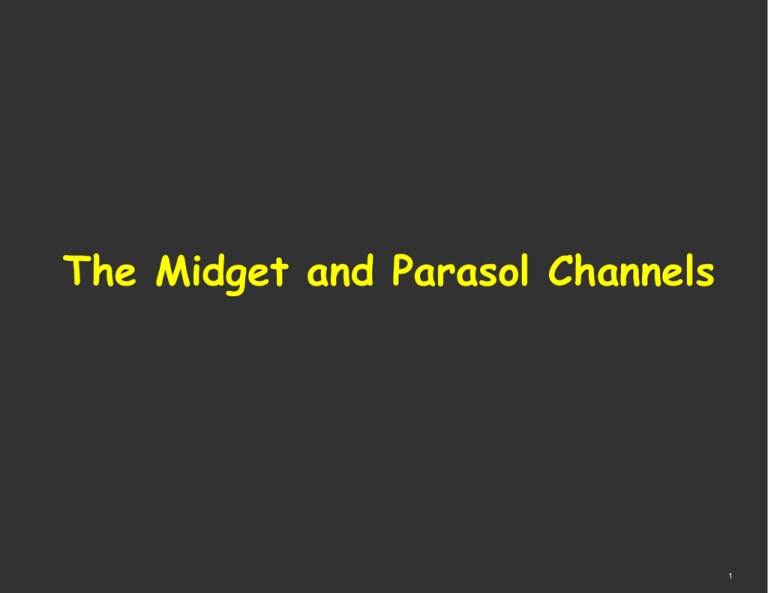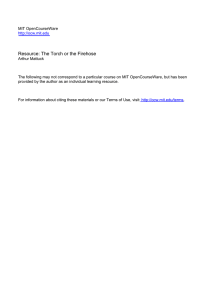
The Midget and Parasol Channels
1
Retinal ganglion cells, cross section, Golgi label
Image removed due to copyright restrictions.
Please refer to lecture video or Figure 4 from Schiller, Peter H.
"Parallel information processing channels created in the retina."
Proceedings of the National Academy of Sciences 107, no. 40
(2010): 17087-17094.
by Polyak
2
Images removed due to copyright restrictions.
Please refer to lecture video or Figure 2c and 3c of Watanabe, M., and
R. W. Rodieck. "Parasol and midget ganglion cells of the primate retina."
JRXUQDORI&RPSDUDWLYH1HXURORJ\ 189, no. 3 (1989): 434-454.
3
Projections of the retinal ganglion cells 10
Cortical projections from LGN
K1
?
M
P
K2
6
5 4
3
V1
2 1
Lamina:
3-6 = parvo
1-2 = magno
interlaminar
LGN
© Pion Ltd. and John Wiley & Sons, Inc.. All rights reserved. This content is excluded from our
Creative Commons license. For more information, see http://ocw.mit.edu/help/faq-fair-use/.
11
The central connections of the midget
and parasol channels 12
Vl complex cell response to moving light bar
Normal
604020-
80-
Parvo Injection
6040-
Spikes per bin
20-
80-
Magno Injection
604020-
80-
Paired Injection
604020-
80-
Recovery
604020-
Image by MIT OpenCourseWare.
14
Recording in V4
Magno Block
Parvo Block
46
36
46
36
Before
Block
After
Block
0
1593
Time (msec)
0
1589
Time (msec)
Image by MIT OpenCourseWare.
15
Recording in MT
Magno Block
Parvo Block
59
179
59
179
Before
Block
After
Block
0
963
Time (msec)
0
963
Time (msec)
Image by MIT OpenCourseWare.
16
1.0
Average blocking index
0.8
0.6
0.4
0.2
0.0
V4
MT
Parvocellular Block
Magnocellular Block
Image by MIT OpenCourseWare.
18
Lesion studies
20
Behavioral procedures
21
The lesions
26
Example of LGN lesions with ibotenic acid Images removed due to copyright restrictions.
Please refer to lecture video or Figure 4 of Schiller, Peter H., Nikos K. Logothetis, and
Eliot R. Charles. "Role of color-opponent and broad-band channels in vision."
VLVXDO1HXURVFLHQFH 5, no. 4 (1990): 312-346.
27
PERCEPTUAL FUNCTIONS TESTED
Contrast
Sensitivity
Color
Pattern
Texture
Shape
Stereopsis
Flicker
Motion
Brightness
Scotopic
Vision
28
Contrast sensitivity
29
Contrast Sensitivity
0.1
0.2
Contrast
0.3
Normal
MLGN Lesion
PLGN Lesion
0.4
0.5
0.6
0.7
0.8
0.9
1
1.5
2
2.5
3
Spatial Frequency (cy/deg)
Image by MIT OpenCourseWare.
33
Color vision
34
Color Discrimination
100
Seneca
90
Percent Correct
80
70
60
50
40
30
20
10
0
Normal
PLGN
MLGN
Image by MIT OpenCourseWare.
36
Brightness perception
37
The perception of brightness in photopic vision
Images removed due to copyright restrictions.
Please refer to lecture video or Figure 16b,d of Schiller, Peter H., Nikos K. Logothetis, and
Eliot R. Charles. "Role of color-opponent and broad-band channels in vision."
VLVXDO1HXURVFLHQFH 5, no. 4 (1990): 312-346.
39
The perception of brightness in scotopic vision
Images removed due to copyright restrictions.
Please refer to lecture video or Figure 13 of Schiller, Peter H., Nikos K. Logothetis, and
Eliot R. Charles. "Role of color-opponent and broad-band channels in vision."
VLVXDO1HXURVFLHQFH 5, no. 4 (1990): 312-346.
40
Pattern and texture perception
41
Texture and Pattern Discrimination
100
Percent Correct
90
80
70
60
50
40
30
20
10
N
P
Texture
M
N
P
M
Pattern
Image by MIT OpenCourseWare.
44
Stereoscopic depth perception
45
46
Images removed due to copyright restrictions.
Please refer to lecture video or Figure 1 of Schiller, Peter H., Geoffrey L. Kendall, Michelle C. Kwak,
and Warren M. Slocum. "Depth perception, Binocular Integration and Hand-Eye Coordination in Intact
and Stereo Impaired Human Subjects." -RXUQDORI&OLQLFDODQG([SHULPHQWDO2SKWKDPRORJ\ 3:210.
47
Stereoscopic depth perception
Images removed due to copyright restrictions.
Please refer to lecture video or Figure 22a,b of Schiller, Peter H., Nikos K. Logothetis, and
Eliot R. Charles. "Role of color-opponent and broad-band channels in vision."
VLVXDO1HXURVFLHQFH 5, no. 4 (1990): 312-346.
48
Motion perception
49
Motion detection
100
esion
90
Normal
80
70
Latencies:
Normal = 318ms
MT Lesion = 362ms
60
50
40
Percent Correct
30
20
V4 Lesion
10
6
8
Eager
10
12
100
90
80
Normal
70
60
MT Lesion
50
40
Latencies:
Normal = 234ms
MT Lesion =278ms
30
20
10
Zeno
6
8
10
12
14
Percent Luminance Contrast
Image by MIT OpenCourseWare.
53
The perception of flicker
54
Flicker perception
Flicker Detection
Peachy
90
Green Flicker
80
Percent Correct
70
60
50
Red/Green Flicker
Normal
40
530
8
11
14
17
20
23
MT Lesion
20
26
V4 Lesion
10
0
5
8
10
Flicker rate (Hz)
15
20
Image by MIT OpenCourseWare.
57
Functions of the midget and parasol systems:
The midget system :
color
texture
fine form
fine stereo
The parasol system:
fast flicker
fast, low contrast motion
Both Systems:
brightness
coarse form
coarse stereo
slow flicker
slow, high contrast motion
scotopic vision
59
Spatial Frequency
H
Processing Capacity
L
H
L
Midget System
Parasol System
Temporal Frequency
H
L
L
H
Image by MIT OpenCourseWare.
60
Summary:
1. Two major channels originating in the retina are the midget and the parasol.
2. In central retina the receptive field center of midget RGC and parvocellular
LGN cells is compised of a single cone.
3. Parasol cells have much larger receptive fields; the cone input is mixed
in both the center and the surround.
4. The midget and parasol cell ratio from center to periphery changes from
8 to 1 to 1 to 1.
5. The midget and parasol systems converge on some of the cells in V1.
6. V4 receives input from both the midget and parasol cells.
7. The major input to MT is from the parasol cells.
8. The midget system extends the range of vision in the wavelength and
high spatial frequency domains
9. The parasol system extends the range of vision in the high temporal
frequency domain.
61
MIT OpenCourseWare
http://ocw.mit.edu
9.04 Sensory Systems
Fall 2013
For information about citing these materials or our Terms of Use, visit: http://ocw.mit.edu/terms.







